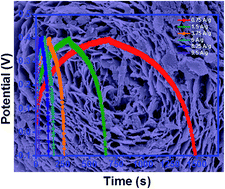Self-assembled flower-like ZnCo2O4 hierarchical superstructures for high capacity supercapacitors†
Abstract
Self-assembled ZnCo2O4 nanosheets were synthesised by a one-step hydrothermal method and their electrochemical supercapacitor properties were investigated in 2 M aqueous KOH solution. Interesting capacitive properties were observed with a superb cyclic stability obtained even at a current density of 20 A g−1. A specific capacitance value of 1691 F g−1 was obtained at a current density of 1 A g−1 with an energy density of ∼57.4 W h kg−1. The experimental findings provide useful insights into the design of supercapacitors for potential high performance energy storage applications in the future.


 Please wait while we load your content...
Please wait while we load your content...